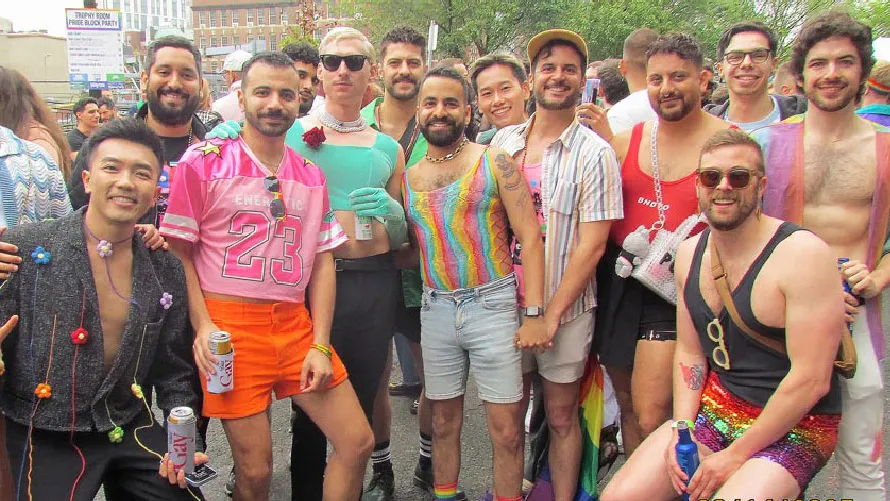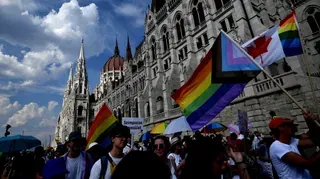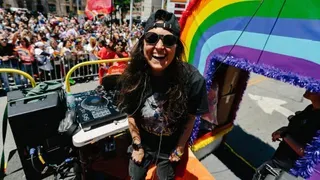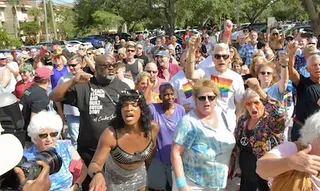June 20, 2013
A Brief History of the Stonewall Riots
Kilian Melloy READ TIME: 4 MIN.
June 28, 1969 at the Stonewall Inn in New York City's West Village started like any other night - until the bar went up in flames.
Gay men, lesbians dressed in men's clothes, and drag queens were dancing the night away at the dingy bar, where you knocked to get inside, the windows were blacked out, music blasted from a jukebox, and the good liquor was stored under the bar (you had to ask Johnny or Mario for that).
Then the cops came.
"I was in jail about 12 times for being in gay bars. Some nights they'd throw us out and we'd go back to the bar the next time. Sometimes they'd take everybody in the bar into the wagons and we'd spend the night in the holding cell," said Tree Sequoia, a patron that evening. "The night of the rebellion, I was there dancing with my friends to a Lindy Hop or a stroll when the cops came."
Sequoia, 74, now works at the Stonewall Inn, a place that he used to frequent as a young man in the 1960s, including the night of the riots. It was illegal for men to dance together, to serve alcohol to a homosexual, and to dress in the clothing of the opposite sex. The cops came in to break up the party, arrest patrons, business as usual. But that night, they fought back.
"These cops were a little more violent. They pushed, they shoved people, they were calling us names," Sequoia said. "In those days it was a sickness we had. Now they know better and the police admitted they were deathly afraid to leave the building."
First a scuffle broke out. Drag queens slipped out through the back door, ripped parking meters from the ground to barricade the cops inside, garbage cans were lit on fire, and soon the bar was on fire. Tree escaped with some friends and watched a mob of hundreds gather outside, waiting to take on the cops. Tree left to eat with friends, not realizing he was feet away from something that would lead to the explosion of the gay rights movement.
"It was the first time the LGBT population fought back against these raids that were discriminatory and had been going on for decades," said Perry Halkitis, professor of applied psychology and public health at New York University. "They weren't fighting back thinking, 'We're fighting for civil rights,' they were fighting back as human beings... In that moment you don't realize you're being part of history."
1969, or the Summer of Love, was a pressure cooker of dissatisfaction with the status quo in society: African Americans pumped their fists for black power, women burned their bras in the liberation movement, and revolutionaries fought against the war in Vietnam. After Stonewall, it was finally the gay movement's turn after unsuccessful demonstrations.
"The first demonstrations were actually in the mid '60s in Washington, D.C. and in New York City but they were quiet, they were peaceful... they didn't really cause a stir," said Nate Klarfeld, Broward chairman for Equality Florida and the former Stonewall Museum board chair.
With the violence of Stonewall, people finally noticed.
"I do honestly believe that the violence - which was used by the African Americans, it was used by the women, it was used by the anti-war movement - did get people's attention."
Klarfeld was a 19-year-old NYU student and working a bartending shift for a catering company the night of the riots. While the newspapers only had a few clippings of the event, word of the riot spread like wildfire throughout the gay community.
"It was the talk for weeks, but nobody ever thought it would go anywhere. We talked about it within our community, we said, 'Is it safe to go out?'" he said.
The following year, New York City saw its first gay pride parade, which has continued to this day. Klarfeld remembers being a part of the parade, which he described as "more of a quick run."
"We were scared of getting shot or rocks thrown at us," he said.
Sequoia remembered laughing at the pride walk - the idea of quality for guys was so outlandish to him.
"When we saw people lined up for the first gay pride we laughed at them, and then after that parade was over, it was considered a march, we thought that was it forever. But who knew that this would be the 44th year," he said.
And 44 years later, June is celebrated as Pride Month within the LGBT community, thanks to the night at the Stonewall Inn. Although it's a night of infamy in some circles, for many young gay people, it's unknown. For Halkitis, President Barack Obama's mention of the Stonewall Riots in his 2012 inauguration speech was surprising; he remembers turning to his partner asking him if he thought anyone listening knew what Obama was talking about.
Although he was only 6 years old at the time, as a gay man, Halkitis credits the state of gay rights today to that fiery night on Christopher Street.
"We do not find ourselves here 44 years later without that event," he said. "My generation, people my age, stand on the shoulders of people before us who couldn't live their life openly."
Kilian Melloy serves as EDGE Media Network's Associate Arts Editor and Staff Contributor. His professional memberships include the National Lesbian & Gay Journalists Association, the Boston Online Film Critics Association, The Gay and Lesbian Entertainment Critics Association, and the Boston Theater Critics Association's Elliot Norton Awards Committee.





